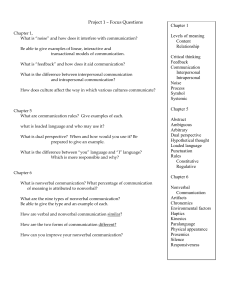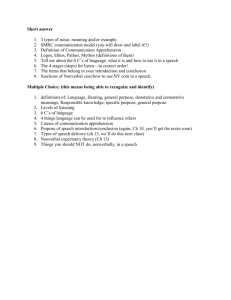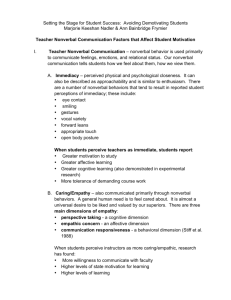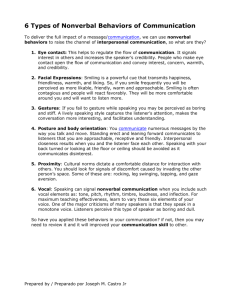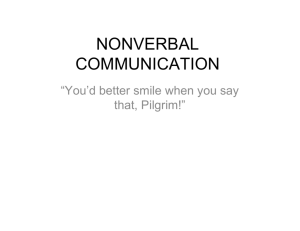Nonverbal Communication
advertisement
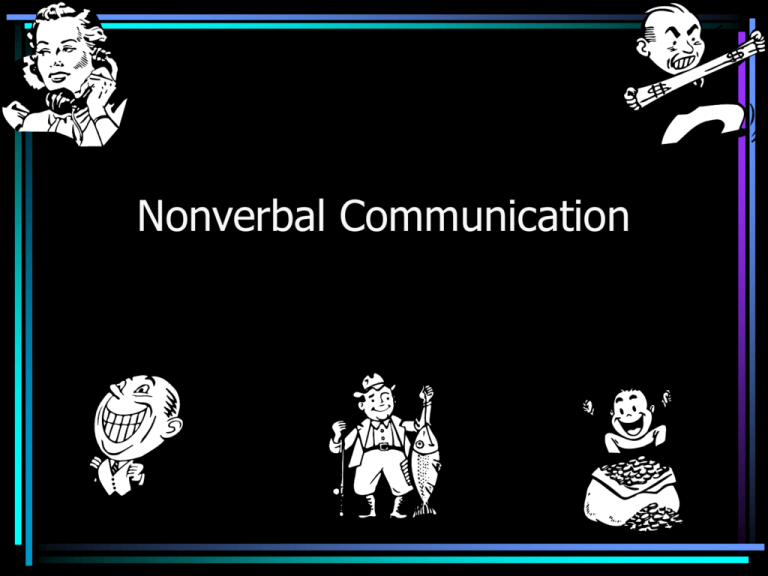
Nonverbal Communication What is nonverbal communication? • “Oral and nonoral messages expressed by other than linguistic means.” • Messages transmitted by vocal means that do not involve language • Sign language and written words are not considered nonverbal communication Nonverbal communication is powerful • 60% of all communication is nonverbal (Burgoon, Buller, & Woodall,1989) There are 7 types of nonverbal behavior • • • • • • • Proxemics Haptics Chronemics Kinesics Artifacts Vocalics or Paralanguage Environment PROXEMICS (distance) • Different cultures have different comfort levels of distance • As children grow older and become less dependent on parents they require more space • Men tend to take up more space than women Example: When you go to the movies with someone of the opposite sex who usually gets the armrest? Edward T. Hall’s 4 levels of distance • • • • Intimate: 0 to 18 inches personal: 18 inches to 4 feet social: 4 to 10 feet public: 10 feet to infinity HAPTICS (touch) The power of touch: • A (1997) study found that strangers that were touched were more likely to return change left in a phone booth(Klienke) • A (1992) study found that food servers who used touch received larger tips (Hornick) • Library study (1976) found that students who were slightly touched by clerk while checking out library books evaluated the library much more favorably than those who were not touched. CHRONEMICS (time) How is time used to communicate? What does it mean to you when someone is always late? A study conducted by Burgoon (1989) found that people who arrive 15 minutes late are considered dynamic, but much less competent, composed and sociable than those that arrive on time. KINESICS (behavior) • • • • • Facial expressions Eye contact Body language Gestures Physical appearance Facial expressions • The face is capable of conveying 250,000 expressions (Birdwhistle, 1970) • Smiling increases sociability, likeability, and attraction(LaFrance & Hecht, 1995) • Food servers who smile more often earn increased tips (Heslin & Patterson, 1982) • Studies conducted on students caught cheating found that students who smiled were treated with more leniency (LaFrance & Hecht, 1995) Eye contact • Successful pan handlers establish eye contact (Beebe, 1974) • People are more likely to comply when more eye contact is used • Eye contact conveys a sense of sincerity • Eye contact establishes a connection between persons Body language • Mirroring – building rapport with others by mimicking their nonverbal cues • People like those who are similar or equal to them • “Mirroring” body language facilitates compliance • Many self-help books suggest mirroring techniques to get people to like them Example: The book Unlimited Power by, Anthony Robbins Gestures • Gestures can be seen as subtle or not so subtle cues • We use gestures to take the place of words, or help us to increase understanding of what is being said Physical Appearance • More attractive people are judged to be happier, more intelligent, friendlier, stronger, and kinder and are thought to have better personalities, better jobs, and greater marital competence (Knapp, 1992) • Attractive people get more dates, higher grades, higher tips, and lighter court sentences than unattractive people (Dunn, 2000) • Example: – In a 1980 study 73 defendants who had been rated on physical attractiveness went to trial. Results showed that the more attractive defendants received significantly lighter sentences (Stewart). ARTIFACTS (Dress, Belongings, etc.) • Material objects as an extension of oneself • Clothing has the power to influence • Change left in a phone booth was returned to well dressed people 77% of the time, poorly dressed people only 38% of the time • Several studies show that fancy suits, uniforms and high-status clothing are related to higher rates of compliance. • The situation governs appropriate dress VOLCALICS (Paralanguage) • Use of voice to communicate includes elements such as pitch, rate, pauses, volume, tone of voice, silences, laughs, screams, sighs, etc. • Studies have found that people who talk louder, faster, and more fluently are more persuasive • Deep voices are often viewed as more credible • Powerless style of communication (pauses, umhs, uhs, tag questions) lowers perceptions of credibility ENVIRONMENT • What we surround ourselves with • Example: The way we decorate our house tells others a lot about us Environment is often used to influence nonverbally • Several researchers have found that supermarkets strategically place products • Staples such as dairy, meat and produce are in the back or on opposite sides of the store, in order to force shoppers to meander through aisles where they’ll be tempted to buy all kinds of other products • Children’s products are usually placed on lower shelves where they can easily be viewed • Snack foods, which appeal to impulsive buyers are usually placed near check-out areas and at the end of isles where they are more likely to be snatched up (Field, 1996; Meyer, 1997: Tandingan, 2001) Functions of Nonverbal Communication • • • • • • • Repeating Substituting Complementing Accenting Regulating Contradicting Deceiving Repeating • The use of nonverbal behavior to say what you are saying in words • Emblems- are the nonverbal behaviors that we use to display what we mean • Example: head nods at the same time as someone saying “yes” Substituting • The use of nonverbal behaviors to say things rather than words • We often answer questions others ask by responding nonverbally rather than verbally Example: Nodding your head to answer a question rather than saying “yes” Complementing • The use of nonverbal behaviors to strengthen what is being said with words. • Illustrators- nonverbal behaviors that support what is being said verbally • Example: A friend says “I am so sorry” and at the same time makes a sincerely sad face Accenting • The way we emphasize certain words in order to clarify what we mean. Example: “NO!” or “No????” Regulating • Nonverbal behaviors that control the flow of the conversation, and tell us when it is our turn to talk, or when the other person is finished talking. Example: while telling a story to a friend, one may pause to allow room for comments Contradicting • When people are saying one thing yet their nonverbal behavior is telling us something completely different. Example: A friend says, “I am so sorry” while smiling In conclusion • A knowledge of the several factors involved with nonverbal communication, and an awareness of its power will improve our ability to communicate with others.

